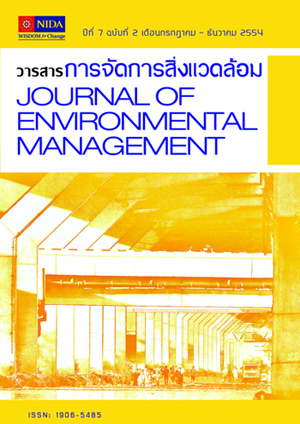การบำบัดตะกอนเลนในบ่อเลี้ยงกุ้งทะเลโดยกระบวนการย่อยสลายแบบไร้ออกซิเจน Treatment of Marine Shrimp Culture Pond Sediment by Anaerobic Digestion Process
บทคัดย่อ
การวิจัยนี้ศึกษาการบำบัดตะกอนเลนจากบ่อเลี้ยงกุ้งทะเลโดยกระบวนการย่อยสลายแบบไร้ออกซิเจนเพื่อการผลิตก๊าซชีวภาพ โดยใช้ตะกอนเลนจากบ่อเลี้ยงกุ้งที่มีวิธีการเลี้ยงแตกต่างกัน 2 แบบ คือ การเลี้ยงกุ้งทะเลแบบไม่ใช้จุลินทรีย์ EM (Effective Microorganisms) ในขณะเลี้ยง และแบบใช้จุลินทรีย์ EM ในขณะเลี้ยง ผลการศึกษาพบว่า การบำบัดตะกอนเลนโดยใช้ตะกอนเลนจากการเลี้ยงกุ้งแบบไม่ใช้จุลินทรีย์สามารถลด TS TDS TSS TVS BOD และ COD ได้ 89% 60% 95% 89% 86% และ 85% ตามลำดับ และจากการเลี้ยงกุ้งแบบใช้จุลินทรีย์สามารถลดได้ 81% 52% 99% 80% 95% และ 95% ตามลำดับ นอกจากนี้ ผลจากการบำบัดตะกอนเลนยังสามารถผลิตก๊าซชีวภาพได้ การหมักตะกอนเลนจากการเลี้ยงกุ้งทะเลแบบไม่ใช้จุลินทรีย์สามารถผลิตก๊าซชีวภาพสะสมทั้งหมดได้ 0.025 ลิตร/กรัม.ซีโอดีที่ถูกกำจัด โดยมีองค์ประกอบของ CH4 CO2 และ N2 ปริมาณเท่ากับ 44.34% 4.91% และ 17.23% ตามลำดับ ส่วนการหมักตะกอนเลนจากการเลี้ยงกุ้งทะเลแบบใช้จุลินทรีย์สามารถผลิตก๊าซชีวภาพสะสมทั้งหมดได้ 0.0015 ลิตร/กรัม.ซีโอดีที่ถูกกำจัด โดยมีองค์ประกอบของ CH4 CO2 และ N2 ปริมาณเท่ากับ 11.75% 3.9% และ 5.18% ตามลำดับ ก๊าซชีวภาพสะสมที่ได้จากการศึกษาครั้งนี้มีปริมาณน้อยกว่าที่ได้จากวัสดุตั้งต้นชนิดอื่น แต่สามารถนำมาใช้เป็นเชื้อเพลิงหุงต้มได้
This research was to study the treatment of sediment in marine shrimp culture ponds by anaerobic digestion process in biogas production, comparing between two culture systems: with and without use of EM (Effective microorganisms) technology in shrimp culture. The results showed that the treatment of pond sediment by anaerobic digestion process could reduce TS, TDS, TSS, TVS, BOD and COD by 89%, 60%, 95%, 89%, 86% and 85%, respectively in the non-EM culture farm, and 81%, 52%, 99%, 80%, 95% and 95%, respectively in the EM-based farm. In addition, the sediment treatment could produce biogas from the digestion. The anaerobic digestion of sediment from non-EM culture showed that the accumulated biogas production was 0.025 l/g.COD removal, and the biogas compositions of CH4, CO2 and N2 were 44.34%, 4.91% and 17.23%, respectively. In the EM-based culture farm, the treatment of pond sediment could produce 0.0015 l/g.COD removal of accumulated biogas, composed of 11.75%, 3.9% and 5.18% of CH4, CO2 and N2, respectively. Although the cumulative biogas production in this study was less than that in other studies using different raw materials, the produced biogas could be used directly as cooking fuel.



